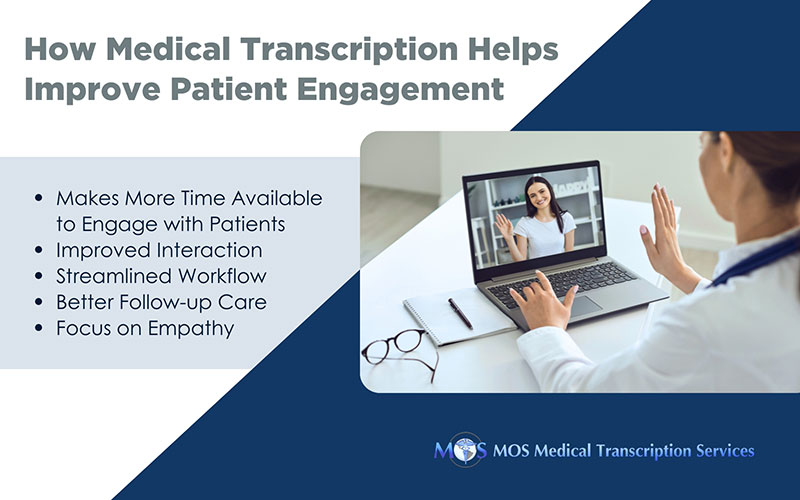
Table of Contents
Empathy is essential for fostering enduring, meaningful relationships in every kind of interaction, especially between doctors and patients. Taking a step back to genuinely understand what patients are going through not only enhances their satisfaction but also leads to better outcomes. This approach can solidify your reputation as a compassionate doctor, which is invaluable for the growth of your practice. However, balancing this empathetic care with administrative tasks can be challenging. Even with the benefits of electronic health records (EHRs) – such as improved patient care, safety, and efficiency – many physicians feel that managing data entry and tracking quality metrics detracts from patient interactions. This is where medical transcription company can help bridge the gap, ensuring doctors can focus on their patients while the administrative burden is handled by experts. By alleviating these pressures, transcription services support both the physician’s need for efficiency and the patient’s need for attention, helping practices maintain a personal, empathetic connection with their patients.
Strategies for Overcoming Distractions and Enhancing Patient Care
In their 2016 Physician Writing Contest, Medical Economics asked readers how they are tackling the challenges of present-day distractions to provide quality care for their patients. Here are some pearls from the prize winners of the contest.
- Prepare for the appointment: Physicians can make each visit more productive by preparing ahead of the consultation. Office staff should call up patients and make sure that they have the necessary tests one week before the visit. This will also help avoid no-shows. Demographic information checks and insurance verification should also be done before the consult, which will save time and enhance patient satisfaction, while improving collections.
- Pre-chart: Based on the complexity of the patient, physicians should spend some time before the visit to assess how his or her condition has changed since the last visit. Reviewing lab-related data a day or two before the consultation will allow the physician spend more quality time with the patient instead of looking at the computer screen.
- Build a patient-focused environment: Practice staff should be trained to use the EHR, so that they can communicate with each other before or after the patient visit. This will make each consultation more patient-focused. The computer should be placed in such a way that physicians can directly see their patients. When serious matters are being discussed, the provider should stop typing and look at the patient. This will make the patient feel comfortable and acknowledged.
- Educate the patient: A physician’s time is valuable. The physician’s team should educate patients on how to make the most of the time spent at the consultation. Matters related to insurance and payments should be discussed outside of the exam room, which will leave more time for medical issues at the consult.

How Doctors Can Increase Patient Engagement with Medical Transcription Services
For healthcare to be successful, meaningful patient engagement is essential because it increases treatment adherence, builds trust, and improves health outcomes. However, attaining this degree of involvement necessitates patience, concentration, and empathy—qualities that are frequently taxed by administrative duties like maintaining patient records. In this situation, medical transcription services are essential in enabling doctors to improve their interactions with patients.
- More Time to Engage with Patients: Doctors no longer have to concentrate on documentation during consultations thanks to medical transcription services. Doctors can focus entirely on listening, comprehending, and empathizing with their patients instead of inputting notes into an electronic health record (EHR) system.
- Improved Interaction: Clear documentation of all patient information, concerns, and doctor’s orders is ensured via accurate transcription of medical notes. This clear communication reduces miscommunication, enables doctors to follow up efficiently, and provides patients with assurance that their problems are being taken care of.
- Streamlined Workflow: Practices can increase productivity and lessen the strain on healthcare personnel by contracting with qualified transcriptionists to handle documentation. A more efficient workflow makes it possible for doctors to remain composed and focused throughout consultations, which significantly improves patient involvement.
- Better Follow up Care: Medical transcription services ensure that doctors have easily readable records to use when scheduling follow-up visits. In addition to helping physicians deliver individualized care, thorough and well-maintained patient records show patients that their medical history and progress are treated seriously.
- Focus on Empathy: Physicians can remain completely attentive during patient contacts while medical transcription services handle documentation, which is essential to ensure empathy. This compassionate approach fosters trust and gives patients confidence that the doctor’s first concern is their well-being.
Even as they build patient engagement and provide quality care, physicians must actively use their EHRs to create legible and organized records with clinical information about individual patients. Partnering with an established medical transcription company would help healthcare providers use their EHR better. EHR-integrated medical transcription services ensure accurate and timely history and physical reports, consultation records, operative reports, lab and imaging reports, clinical notes and discharge summaries. The support of a reliable company can prove invaluable for physicians as they work towards their goal of improving the quality and safety of healthcare in the EHR age.


